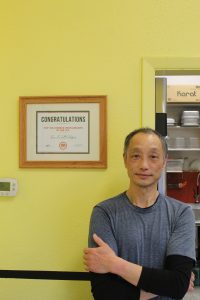New Human Services Resource Center Funding
February 28, 2018
Mainstream media can often glamorize the college lifestyle, but at Oregon State University’s Human Services Resource Center (HSRC) they see a different side to the story. Nicole Hindes, Assistant Director, spends her day bringing support to the Corvallis, Ore. community and with the help of increased funding this has become an easier task.
The HSRC tackles food security, food assistance, housing, and textbook lending. They also open up their food services to the community. “We have so many services for students and the community,” Hindes said.
Within the last year, HSRC has taken a new approach to advertising for their services. They have been hosting classes and they have even turned to Twitter to spread their movement. They have reached about 750 account followers.
“People don’t expect to find food pantries on a college campus,” Hindes shared.
With the renovated approach to advertising, the HSRC took a leap of faith and developed a request to receive increased funding. The HSRC was the only student affairs funded unit that was asking for an increase decision package. Most of the other units had an increase, but that was because the cost of everything else went up, according to Hindes. “We were the only ones who had an increase because we needed to do something different,” Hindes said.
“We pitched the idea to the student fee committee, and they would give us the thumbs up or the thumbs down,” Hindes said, “They were supportive and passed our increase.”
After the student fee committee passed their increase, they were voted down by the joint session of congress of Associated Students of Oregon State University because they wanted to give them more money. The HSRC needed to strategically plan a budget and administrate a plan of how they would use this money.
“This was challenging because I had approximately eight days to come up with a strategy to show what growth would look like,” Hindes said.
Hindes and the rest of the HSRC team have been collecting data throughout the year, and they used this information to make their proposal. The HSRC met with the mediation committee and shared their vision with them.
“We had a lot of help with both student input and professionals on campus,” Hindes said.
After all the hard work that was put into this proposal, the HSRC was granted with an increase in funding for the upcoming year. With that, Hindes and the rest of the service planned a phased process to enhance the HSRC.
By July 2, they will have hired a new basic needs navigator. Within the first year they will be able to have enough student staffing to be able to stay at their food pantry three days out of the month.
They were able to increase their food assistance by roughly 15 percent, and this helps students buy meals on campus through one of their food security programs. Just this last academic year, the HSRC saw a 35 percent increase in the amount of people using their food services in the Corvallis community.
The HSRC will also be able to better help students in a housing crisis by being able to house them in hotels in the community. By the third year of this phasing process, they are hoping to be able to build a library.
Hindes is hopeful for the future of the HSRC and the community that surrounds this service with this increased amount of funding. “There is always room for improvement,” Hindes said.
Photography by Katie Smith via unsplash.com






